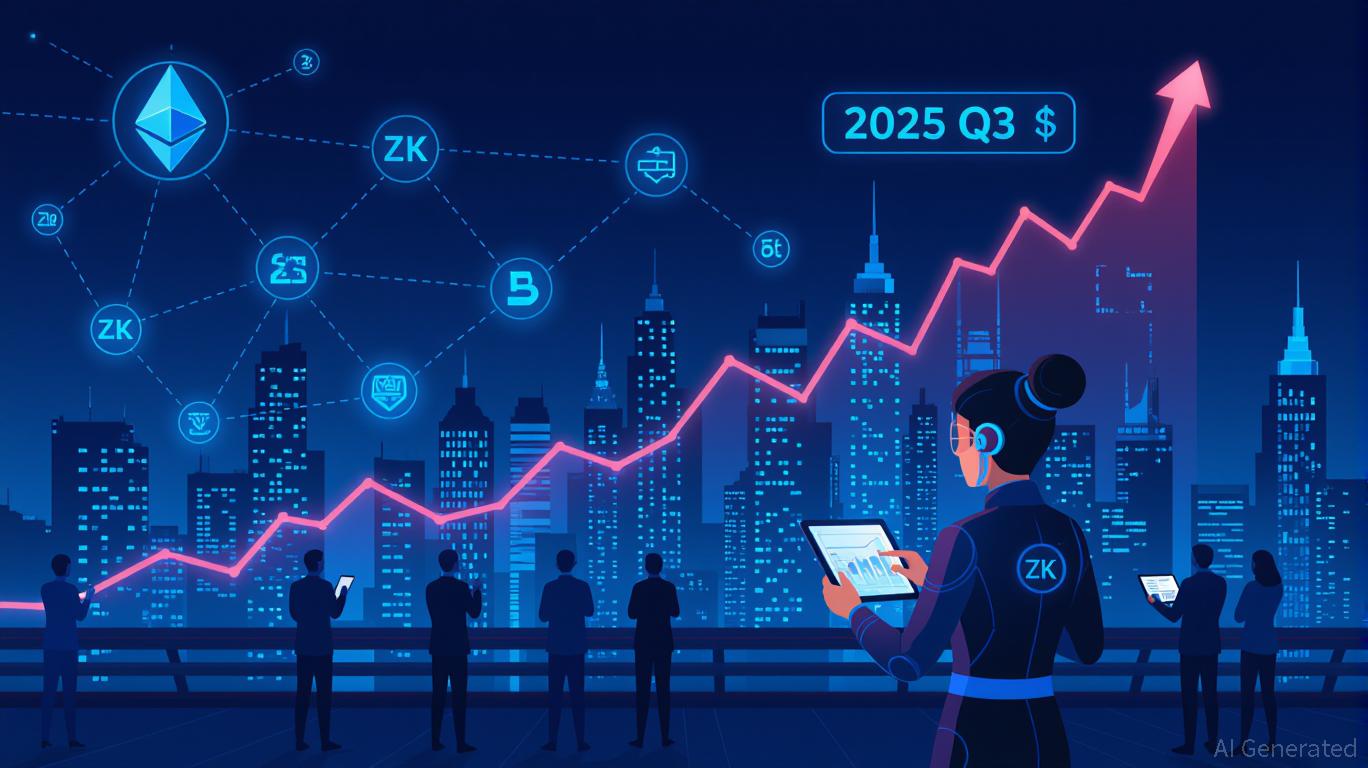Vitalik Buterin Introduces New ZK Technology: What It Means for Ethereum's Development
- Vitalik Buterin leads Ethereum’s shift to ZK proofs, targeting modexp removal and GKR protocol integration to boost scalability and privacy. - Modexp precompile’s 50x computational burden on ZK-EVM proofs will be replaced by standard EVM code, prioritizing long-term efficiency over short-term gas costs. - GKR protocol enables 2M Poseidon2 hashes/sec on consumer hardware, accelerating verification and enhancing quantum resistance for Ethereum’s "Lean Ethereum" vision. - ZKsync’s 150% token surge and Citib
Ethereum has consistently evolved by embracing new technological trends. In 2025, co-founder Vitalik Buterin is leading a major transition toward zero-knowledge (ZK) proof systems, with new proposals aimed at updating Ethereum’s core code to enhance both scalability and privacy. These updates, such as eliminating the modexp precompile and implementing the GKR protocol, are significantly impacting the investment outlook for Layer-2 networks and privacy-oriented digital assets.
The Modexp Precompile: An Outdated Constraint
Buterin has pointed out that the modexp precompile—a legacy tool for modular exponentiation in RSA encryption—has become a significant barrier to
Initially introduced for cryptographic tasks like RSA, the modexp precompile now serves only a tiny portion of users (about 0.01%), as
GKR Protocol: Advancing ZK Performance
Alongside the modexp update, Buterin’s GKR protocol introduces a cutting-edge proof system that speeds up transaction validation while maintaining privacy. According to a
The GKR protocol is central to Ethereum’s “Lean Ethereum” initiative, which focuses on efficiency, speed, and security. By reducing the resources needed for on-chain verification, GKR enables near-instant transaction finality and encourages greater institutional participation. For instance, Citibank and Mastercard have already adopted ZKsync’s Prividium platform for privacy-first infrastructure, indicating a move toward enterprise-level blockchain solutions, as reported by Bitget.
Market Impact: ZK-Fueled Expansion and Enterprise Interest
Interest in ZK-powered assets is rapidly

Another major factor is the rise of institutional involvement. The Ethereum Foundation’s “Ethereum for Institutions” initiative, led by Igor Barinov, is speeding up the adoption of privacy technologies like ZK proofs and homomorphic encryption, as covered by Yahoo Finance. These initiatives aim to balance regulatory requirements with secure, programmable financial systems, making Ethereum increasingly appealing to large organizations.
Investment Outlook: Weighing Opportunities and Challenges
Despite these technical breakthroughs, investors should consider possible downsides. Removing the modexp precompile may initially raise gas costs for older applications, but Buterin maintains this is essential for future efficiency, as CryptoNews reported. The long-term success of ZK projects also depends on how well they integrate with the broader ecosystem and the practical use of their tokens. For example, ZKsync’s move to a revenue-linked utility token creates a positive feedback loop, increasing its investment potential, according to Bitget.
Financial analysts recommend evaluating ZK assets based on three main criteria:
1. Technical Innovation: Projects actively developing new protocols like GKR and alternatives to modexp.
2. Ecosystem Connectivity: Collaborations with major institutions and Layer-2 platforms.
3. Token Utility: Models that drive value through network participation and growth.
Conclusion
Vitalik Buterin’s ZK initiatives are charting a new course for Ethereum, establishing it as a frontrunner in scalable and privacy-focused blockchain technology. Investors should pay close attention to projects that harness these advancements—such as
Disclaimer: The content of this article solely reflects the author's opinion and does not represent the platform in any capacity. This article is not intended to serve as a reference for making investment decisions.
You may also like
Bitcoin Updates: Crypto Market Divides as Pessimism Clashes with Institutional Confidence in Ethereum
- US stocks closed mixed on Nov 7, 2025, as Bitcoin fell below $100,000 amid $711.8M in crypto liquidations. - ARK Invest boosted Ethereum exposure by buying $9M of BitMine shares, signaling institutional confidence in ETH treasuries. - UK aligns stablecoin rules with US by Nov 10, while crypto firms form consortium to standardize cross-border payments. - Coinbase and Block underperformed revenue forecasts, with Block down 9% despite $6.11B revenue. - Market remains divided between Bitcoin bearishness and
Bitcoin Updates: Cango Utilizes Energy-Efficient Infrastructure to Connect Bitcoin Mining with the Future of AI Computing
- Cango Inc. transitions from auto platform to Bitcoin mining and AI HPC, leveraging global infrastructure and energy expertise. - Achieves 50 EH/s mining capacity in 8 months, with Q2 2025 revenue of $139.8M and $656M in Bitcoin holdings. - Acquires 50 MW Georgia facility to optimize energy costs and expand dual-purpose infrastructure for AI workloads. - Plans direct NYSE listing to enhance transparency amid regulatory scrutiny and industry shifts toward hybrid AI-mining models. - Aims to refresh 6 EH/s e

XRP News Today: MoonBull Secures Liquidity While Solana Holds $160—Can XRP Spark the 2025 Bull Market?
- MoonBull ($MOBU) gains traction with Ethereum-based presale, projecting 9,256% ROI if it hits $0.00616 listing price. - Solana (SOL) consolidates near $160 support level amid $323M institutional inflows, while XRP sees 15% price drop but rising wallet growth. - Ripple's Palisade acquisition boosts institutional focus, yet XRP's price divergence raises questions about adoption vs. valuation. - Analysts highlight MoonBull's 2-year liquidity lock and structured 23-stage presale as differentiators in crowded

Solana News Update: Institutional Trust in Solana Strengthens as Retail Markets Fluctuate
- Solana leads blockchain payment standardization efforts as Ripple acquires Palisade and invests $4B in crypto infrastructure expansion. - Forward Industries authorizes $1B Solana-backed share buyback, signaling institutional confidence in blockchain treasury systems. - Market volatility highlighted by $22.7M whale loss contrasts with SOL Strategies' 6.68% APY, showing diverging risk profiles between retail and institutional players. - Solana Company shifts regulatory focus to U.S. compliance to optimize